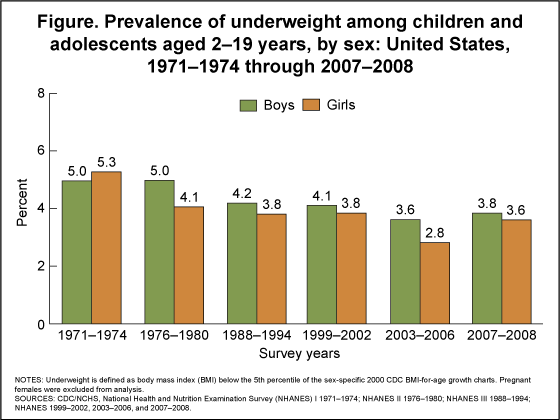NCHS Health E-Stat
Prevalence of Underweight Among Children and Adolescents: United States, 2007-2008
Cheryl D. Fryar, M.S.P.H., and Cynthia L. Ogden, Ph.D., Division of Health and Nutrition Examination Surveys
PDF Version (63 KB)
Underlying health conditions in children and adolescents can result in underweight. In addition, among children, underweight can reflect malnutrition. Results from the 2007-2008 National Health and Nutrition Examination Survey (NHANES), using measured heights and weights, indicate that an estimated 3.7% of children and adolescents aged 2-19 years are underweight (Table 1). Trends from 1971-1974 through 2007-2008 reveal an overall significant decrease in underweight among children and adolescents, from 5.1% to 3.7%. Underweight decreased significantly, from 5.8% to 3.8% among 2-5 year olds and from 5.3% to 3.0% among 6-11 year olds, during this period. Among adolescents aged 12-19, there was no significant change during the same time period. Between 2003-2006 and 2007-2008, there were no significant changes in prevalence of underweight for any of the age groups.
No significant gender differences were seen in the prevalence of underweight in any of the survey time periods.
Table 2 shows the estimates of underweight prevalence for girls and boys aged 2-19 years. (The National Health Examination Surveys (NHES) cycle II (1963-1965) and cycle III (1966-1970) did not include children aged 2-5 years.) Trends in the prevalence of underweight among girls decreased significantly between 1971-1974 and 2007-2008, from 5.3% to 3.6% (see Figure). There was no significant change in the prevalence among boys, however, during this time period. Body mass index (BMI)--expressed as weight in kilograms divided by height in meters squared (kg/m2)--is commonly used to classify weight status among children. Cutoff criteria are based on the sex-specific 2000 CDC BMI-for-age growth charts for the United States. In accordance with current recommendations of expert committees, children with BMI values below the 5th percentile in the charts are categorized as underweight.
NHANES uses a stratified multistage probability sample of the U.S. civilian noninstitutionalized population. A household interview and a physical examination are conducted for each survey participant. During the physical examination, performed in a mobile examination center, height and weight are measured as part of a more comprehensive set of body measurements. These measurements are taken by trained health technicians using standardized measuring procedures and equipment. Observations for pregnant females and for persons missing a valid height or weight measurement were not included in the data analysis.
Figure
Tables
Table 1. Prevalence of underweight among children and adolescents aged 2-19 years: United States, selected years 1963-1965 through 1999-2008
| Age | NHES1 1963-1965 1966-1970 |
NHANES I 1971-1974 |
NHANES II 1976-1980 |
NHANES III 1988-1994 |
NHANES 1999-2002 |
NHANES 2003-2006 |
NHANES 2007-2008 |
|---|---|---|---|---|---|---|---|
| Total | --- | 5.1 | 4.5 | 4.0 | 3.7 | 3.3 | 3.7 |
| 2-5 years | --- | 5.8 | 5.3 | 4.3 | 3.8 | 2.8 | 3.8 |
| 6-11 years | 5.8 | 5.3 | 4.2 | 3.9 | 3.8 | 2.7 | 3.0 |
| 12-19 years | 4.6 | 4.7 | 4.4 | 3.9 | 3.7 | 3.8 | 4.2 |
--- Data not available. Children aged 2-5 years were not included in the surveys undertaken in the 1960s.
1Data for 1963-1965 are for children aged 6-11 years; data for 1966-1970 are for adolescents aged 12-17 years (not 12-19 years).
NOTES: Underweight is defined as body mass index (BMI) less than the sex- and age-specific 5th percentile from the 2000 CDC BMI-for-age growth charts. Pregnant females were excluded from analysis beginning with 1971-1974. Pregnancy status was not available for 1963-1965 and 1966-1970.
SOURCES: CDC/NCHS, National Health Examination Survey I (NHES) 1963-1965; NHES II 1966-1970; National Health and Nutrition Examination Survey (NHANES) I 1971-1974; NHANES II 1976-1980; NHANES III 1988-1994; NHANES 1999-2002, 2003-2006, and 2007-2008.
Table 2. Prevalence of underweight among children and adolescents aged 2-19 years, by sex: United States, selected years 1971-1974 through 1999-2008
| Sex | NHANES I 1971-1974 |
NHANES II 1976-1980 |
NHANES III 1988-1994 |
NHANES 1999-2002 |
NHANES 2003-2006 |
NHANES 2007-2008 |
|---|---|---|---|---|---|---|
| Total | 5.1 | 4.5 | 4.0 | 3.7 | 3.3 | 3.7 |
| Male | 5.0 | 5.0 | 4.2 | 4.1 | 3.6 | 3.8 |
| Female | 5.3 | 4.1 | 3.8 | 3.8 | 2.8 | 3.6 |
NOTES: Underweight is defined as body mass index (BMI) less than the sex- and age-specific 5th percentile from the 2000 CDC BMI-for-age growth charts. Pregnant females were excluded from analysis.
SOURCES: CDC/NCHS, National Health and Nutrition Examination Survey (NHANES) I 1971-1974; NHANES II 1976-1980; NHANES III 1988-1994; NHANES 1999-2002, 2003-2006, and 2007-2008.
This Health E-Stat from NHANES supersedes the earlier version below.



